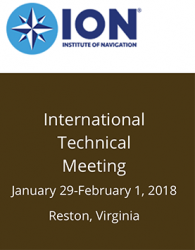The Institute of Navigation’s (ION) annual international technical meeting (ITM), held in conjunction with the Precise Time and Time Interval Meeting (PTTI), kicked off today at the Hyatt Regency Reston in Reston, Virginia.
The event, which runs through Thursday, Feb. 1, began with the opening of the exhibit hall at 8:30 a.m., where exhibitors from several companies involved in receiver, simulator, timing and other GNSS technologies are displaying their products and technologies this week. The ITM/PTTI Plenary session followed at 10 a.m. with Dr. Barbara Giles’ presentation: “When Navigators Become the Scientists: NASA’s Magnetospheric Multiscale Mission.” Dr. Giles is the Associate Chief Geospace Physics Laboratory and Lead for the NASA MMS Fast Plasma Investigation, NASA Goddard Space Flight Center.
Following the Plenary Session, Tuesday afternoon featured several technical sessions covering both PTTI topics and a variety GNSS presentations with tracks categorized as Algorithms for GNSS Processing and Sensor Integration; Advanced Integrity for Autonomous Systems; and Time Scales and Laboratory Activities.
Wednesday and Thursday also will include several technical sessions and the Annual Awards Luncheon will take place on Thursday. The Precise Time and Time Interval Systems and Applications meeting is an annual conference sponsored by ION with a technical program designed to disseminate and coordinate PTTI information at the user level, review present and future PTTI requirements, inform government and industry engineers, technicians, and managers of precise time and frequency technology and its problems, and provide an opportunity for an active exchange of new technology associated with PTTI. The conference once again is co-located with the ION International Technical Meeting.
Among Tuesday’s presentations was one by Jan-Joran Gehrt titled “High Precision Localization with Dual-Constellation for Railway Applications.” Gehrt, from the RWTH Aachen University in Germany, explained how using methods of high precision localization with two constellations (in this case GPS and Galileo) can reduce trackside equipment and reduce costs; requires trainside integrity supervision; and realize moving blocks.
While he explained more needs to be done to check GNSS integrity in railway control systems, the experiments conducted in Germany – with support from the Federal Ministry for Economic Affairs and Energy – were very promising using dual constellation for high accuracy and differential setting.
Prior to the PTTI/ITM conference, ION’s Cognizant Autonomous Systems for Safety Critical Applications Workshop (CASSCA) took place on Monday, also in Reston. The workshop discussed the opportunities and challenges (technical, commercial, ethical, and legal) associated with developing fully autonomous systems that are cognizant and trustworthy for safety critical applications.






